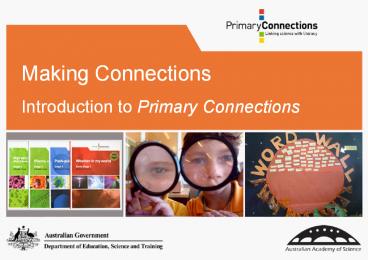Making Connections - PowerPoint PPT Presentation
1 / 23
Title:
Making Connections
Description:
Making Connections Introduction to Primary Connections Making Connections: Introduction to Primary Connections Introduction to Primary Connections The Primary ... – PowerPoint PPT presentation
Number of Views:341
Avg rating:3.0/5.0
Title: Making Connections
1
Making Connections Introduction to Primary
Connections
2
Introduction to Primary Connections
- The Primary Connections Team
- January 2007
3
Outcomes
- On completion of this module participants should
be able to - Clarify their beliefs and concerns about
effective teaching and learning of science in
primary school - Understand and describe the philosophy and
approach of Primary Connections - Understand the background, purpose, organisation
and research behind Primary Connections - Understand and describe the five main
underpinning principles - Understand and describe the exemplary curriculum
resources and the ways they support effective
teaching and learning of science and literacy in
primary schools
4
Workshop Outline (2 hours)
- INTRO (5 mins) Purpose, outline, outcomes
- ENGAGE (15 mins) Participant beliefs and
concerns - Sharing opinions
- EXPLORE (60 mins) The five underpinning
principles - EXPLAIN (15 mins) What is Primary Connections
and how was it - developed?
- ELABORATE (15 mins) Exemplary curriculum units
- EVALUATE (10 mins) Summary, self assessment and
evaluation
5
Purpose of the workshop
- To introduce the Primary Connections program so
that you are - able to make informed decisions about its
benefits in enhancing the - teaching and learning of science and literacy.
- Is this your bus? Will you get on it?
6
What is Primary Connections?
supported by quality curriculum resources
Professional learning programme linking science
with literacy
7
Purpose of Primary Connections
- To
- improve learning outcomes for primary students in
science and - literacy
- by
- developing a professional learning program
supported with - curriculum resources
- that will
- improve teachers confidence and competence for
teaching - science through developing their science
pedagogical content - knowledge.
8
Scientific literacy
- Scientific literacy is a high priority for all
citizens, helping them - to be interested in, and understand the world
around them, - to engage in the discourses of and about
science, - to be sceptical and questioning of claims made
by others about scientific matters, - to be able to identify questions, investigate
and draw evidence-based conclusions, and - to make informed decisions about the environment
and their own health and well-being. - (Goodrum, Hackling Rennie,2001, p. 7)
9
Scientific literacy develops
- _____________________________________________
- None/very little career scientist
- The notion of progress in scientific literacy is
fundamental to - the growth in students knowledge and
understanding of - scientific concepts and processes and the
ability to use that - knowledge and understanding in everyday
situations. - (Goodrum, Hackling, Rennie 2001)
10
Principle 1Linking science with literacy
- Use everyday literacies to learn about science
concepts and the literacies of science - Represent and communicate science ideas,
understandings and information by learning and
using the literacies of science - Provide a meaningful science context and a
purpose for literacy learning
11
Moulds
- What do you know?
12
Principle 2The 5Es teaching/learning model
- ENGAGE
- EXPLORE
- EXPLAIN
- ELABORATE
- EVALUATE
13
The Primary Connections 5Es model
14
Principle 3Teaching and learning about science
with an inquiry/investigative approach
15
Principle 4Co-operative learning strategies
- Director
- Speaker
- Manager
- Each role has specific duties
- and responsibilities as the
- students work through the
- activities.
16
Assessment activity
Draw arrows on the diagram to show any pushes and
pulls.
17
Principle 5Linking assessment with teaching and
learning
- PHASE OF THE MODEL ASSESSMENT FOCUS
- ENGAGE PHASE DIAGNOSTIC
- EXPLORE PHASE FORMATIVE
- EXPLAIN FORMATIVE
- ELABORATE SUMMATIVE (investigating)
- EVALUATE SUMMATIVE (concepts)
18
The origin of Primary Connections- a
collaborative project
- Australian Academy of Science project
- Funded by Department of Education, Science and
Training as a quality initiative under the
Australian Government Quality Teacher Program
(AGQTP) - Research consultants in both science and literacy
education - Reference Group consisting of representatives
from - Australian Academy of Science
- Department of Education, Science and Training
- Universities
- Literacy, English and Science Educator
Associations - State Education Departments
- Catholic and Independent Schools Associations
- Australian Primary Principals Assocation
19
Research findings
- Primary Connections was trialled by 106 teachers
in 56 schools across - all states and territories in 2005 and 2006.
- Primary Connections
- improved teachers confidence, self-efficacy and
practice - increased the amount of science taught
- had students responding positively to the
activities and learning approach - made a positive contribution to literacy learning
and students used a wider range of forms of
representation - improved the status of science within the school
- (Hackling Prain, 2005)
20
Primary Connections organisation Stages, years
and outcome levels
Levels are based on the National Scientific
Literacy Progress Map
21
Curriculum resource organisation
22
Exemplary curriculum units resources
23
In summary, Primary Connections
- links science with literacy
- is based on the 5Es teaching and learning model
- uses an inquiry/investigative approach
- uses co-operative learning strategies
- embeds the assessment processes in the teaching
and learning model - provides exemplary curriculum units and other
resources - AND all of these contribute to the development of
- scientific literacy in primary age students!































